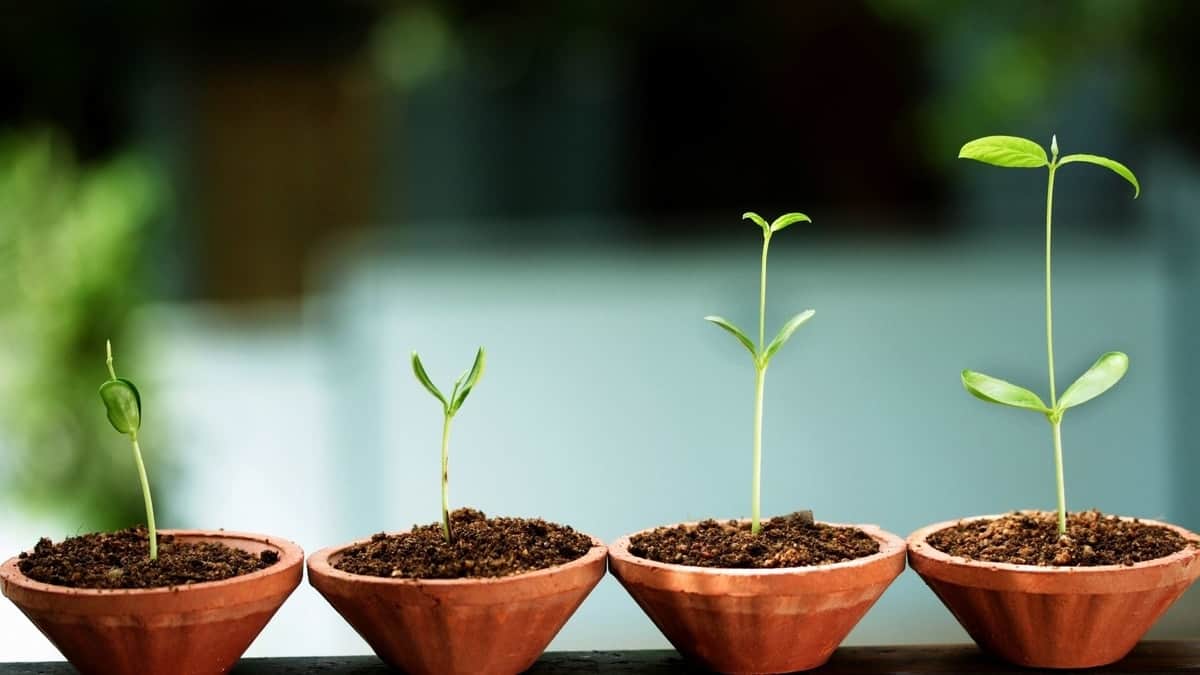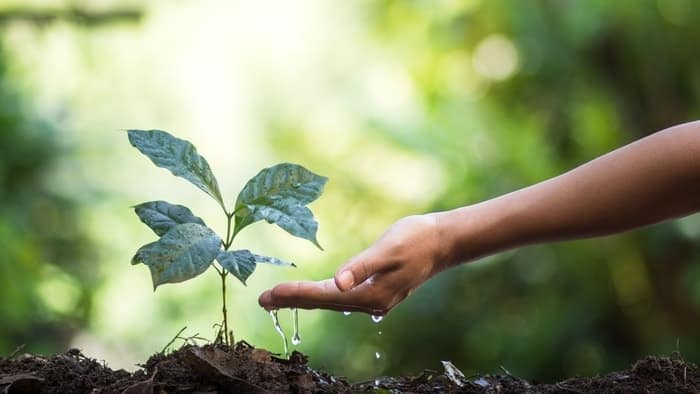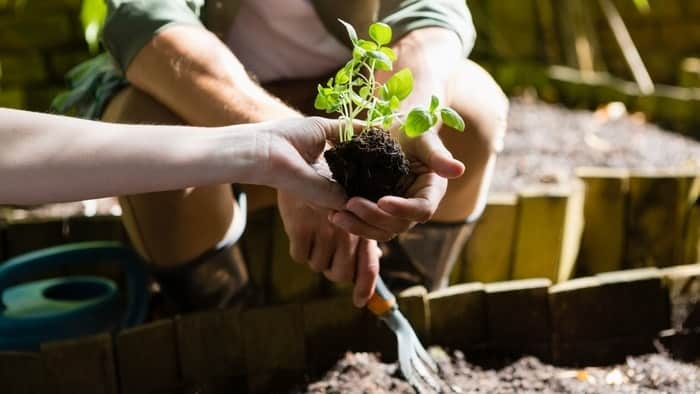Last Updated on January 6, 2022 by
Plants grow in their natural environment with everything they need. But when we create a garden, we make sure that we provide the plants with everything they need for them to survive and grow like the ones in nature.
Humans need air, food, and water to be alive. And like humans, plants also have certain needs for survival and growth.
We want our plants to grow well and look good in a garden environment.
What Does a Plant Need to Survive and Grow?
There are many things plants need to survive and grow. These are water, nutrients, water, light, temperature, space, and time.
We will look at why these things are important for our plants to grow really well.
Water and Nutrients
Plants are made up of around 90% water. Water acts like blood. It transports every part of the plant that needs it.
The water gets sucked up through wall root hairs and it evaporates through the leaves. As the water evaporates, the carbon dioxide enters. The process of water entering the root hairs is how plants absorb minerals… and nutrients from the soil.
The faster the plant grows, the more water it needs. Also, the hotter and drier the air, the more water your plant needs. But there are times when a plant can’t cope up with the amount of water needed. It usually happens when it’s too hot or there is not enough water at the roots. During that time, a plant will stop growing and the leaves will start to wilt.
When you see that the leaves start to wilt, your plant needs urgent attention. If you ignore it, your plant may die. Once the temperature drops or the plant has enough water and the water pressure returns to normal… then, normal growing conditions will resume.
That is why newly planted plants need watering on a regular basis. Do it until their root system is established into the surrounding soil. And they are able to gather water and moisture.
You need to know some useful tips in taking care of your plants so you are on the right track.
Light
As humans, we need energy for growth. And we get our energy from food. In the same way, plants need the energy to grow. They get their energy from light.
Different plants need different amounts of light. Some need more than others. Some plants grow in low light. These are plants that we usually grow as houseplants and ferns. Also, the tropical plants that live naturally under the canopies of trees. The indoor conditions of our home are almost the same as that of the tropical jungle. When it comes to shade and temperature.
There are plants that love the sunlight. And they need a lot of direct sunlight. Otherwise, they will become leggy and grow weak. If they don’t get enough sunlight, they will not produce flowers either.
If you grow vegetables and plants from seed, provide seedlings with enough light. Give them light for the right amount of time. Otherwise, they will become leggy.
Temperature (Warmth)
Plants have evolved. And some are able to adjust to suit different regimes.
We can see plants almost everywhere on earth. But there are temperature differences around the globe. The same plants don’t grow everywhere. For some plants, we need to use greenhouses or conservatories. Especially if the plants are exotic species.
That is why it is important to know your own garden temperature or climate. Also, know the hardiness of the plant.
Growing plants from seed need warmth to germinate. You may have heard of the terms “soil warmth” or “when the soil has warmed.”
If temperature drop reactions inside cells slow down… growth and metabolism also slow down. It is one of the greenhouse tips you need to know. Plants native to areas or environments with sub-freezing winters survive by going dormant. Warmer weather wakes them up and begins vegetative growth again.
Soil
Have you heard of the method of growing plants called “hydroponics”? It is the system of growing plants in the water and adding nutrients. This method is mainly used by commercial growers. And not your common gardener.
Plants can grow without soil. But they can’t grow without the necessities that soil provides.
So, why do plants need soil?
Soil is where plants can grow. And get the chemical elements (nutrients). They are mineral and non-mineral. But a plant’s capability of absorbing these nutrients depends on the composition of the soil. Its the amount of sand, clay, and organic matter within it. The ideal soil composition would be equal amounts of sand, clay, and organic matter. Soil composition can affect water retention and nutrients available. It provides support and anchor for roots to hold on to as the plant is growing. The plants use the roots to absorb moisture and nutrients from the soil.
Also, soil provides air for plants’ roots. They get the air from space between tiny soil particles.
Air
Here are the two main reasons why plants need air:
- Plants need the air from above the ground
Air provides plants the oxygen and carbon that they need. This is for them to photosynthesize (the process of how plants grow).
- Plants need air from below the ground
They need oxygen to breathe. They get this air from tiny air spaces between soil particles.
Good soil drainage allows air to go to the soil for the roots to use. This prevents root failure. And plants cannot function properly when roots fail. It can greatly affect their ability to absorb water and nutrients. Also, root failure is a common cause of plant stress. This is quite common with houseplants.
Space and Time
Space is another factor to consider when growing plants. The root and leaves need room to grow. Because plants can become stunted or too small without enough space or room. Overcrowded plants are also more likely to suffer from diseases. Because airflow may be limited.
And finally, plants need time for growth. They don’t grow overnight; it takes time and patience to grow plants. Most of them need a particular number of days, months, or even years to produce flowers and fruits.
Summary
There are different types of plants growing in different environments. But they need the same things with different amounts of them for them to grow and survive. The elements above provide the plant the basic nutrients. They give the plants the ability to grow and survive.
FAQs
What are the 5 things a plant needs to survive?
A plant can survive without sunlight, air, water, soil and nutrients. However, a plant that is deprived of any of these five things will die.
They need to be watered regularly so that they grow healthy and big.
It is important to note that plant’s needs are different in nature. Some plants require more water while some need less.
What causes a plant to grow?
Plants need light for their photosynthesis process, which is the process that manufactures energy from sunlight. In order to produce energy from light, plants use chlorophyll and pigments that absorb the sun’s rays on a leaf and make use of them. Chlorophyll is what makes a plant green and it is found in all plant cells, while other pigments are produced in just ripe leaves or flowers.
What is the process of growing a plant?
The first step in the process is planting. After that, seedlings have to be transplanted before they will start to sprout. Once they are roughly at the same size as their parent plant, they will be placed in their final locations and watered regularly.
What things does a seed need to grow?
A seed needs at least one of three things: soil with good drainage, water or heat which will start its germination process; once these conditions are met it will sprout with the help of sun light and nutrients from the soil.
What do plants need during photosynthesis?
Plants require some light, carbon dioxide, water, and chlorophyll to complete photosynthesis.
The process of photosynthesis converts light energy into chemical energy that is stored in organic molecules.
How do plants feed?
Plants feed in two ways:
- Photosynthesis is the process that converts light into chemical energy, like carbohydrates and sugars.
- The other way plants feed is by absorbing nutrients from the soil.
Most plants use a combination of both methods to get what they need.
The two types of photosynthesis: Carbon fixation and oxygen release:
Carbon fixation: when carbon dioxide and water react together, it produces sugar and oxygen.
Oxygen release: when plants absorb CO2 from the air, it produces glucose which then releases oxygen from the plant’s leaves.
Why do plants need sunlight?
Plants need sunlight for two very important reasons - photosynthesis and growth.
Photosynthesis is when plants use the sun's energy to create food energy in the form of sugar. They do this by absorbing light from sunlight in order to convert CO2 into simple sugars. Sugar is then converted into glucose, which provides them with energy to grow.
Sunlight also plays a role in regulating plant's circadian rhythm or biological clock. This is when plants change their behavior based on the time of day. So during the day, they grow towards sunlight while during the night, they turn away from it in order to sleep through it.
What plants need a lot of sun?
Plants need sun to grow. Most plants need at least six hours of direct sunlight every day, but the amount of sunlight needed for each plant varies.
There are various plants, flowers, and trees that require a significant amount of sunlight.
Some plants that need a lot of sun are:
- Palms: palms need a lot of sun because they have evolved to grow in tropical climates where the sun shines all day long. They don't do well in shady places, so they need a big enough space to grow.
- Fruit trees: fruit trees also need lots of sun because the fruit needs the sunlight for photosynthesis to convert sugar into food to feed their growth.
- Flowering plants: flowering plants also require a significant amount from the sun as it helps them produce chlorophyll for photosynthesis which is an important part of their survival.
Sunlight is most important for photosynthesis, which is the process by which plants turn light energy into chemical energy they can use. Sunlight activates pigments in leaves that help them capture light and use it to produce oxygen and organic sugars through a biochemical reaction called photosynthesis. These sugars are converted into starches and fats for storage, or used immediately as food to fuel growth.
Tony Manhart is a passionate gardener who has been tending to gardens for over 20 years. He takes pride in creating beautiful outdoor spaces with plants, trees, and shrubs that can thrive in any environment. He loves to share his knowledge with others and has taught classes on gardening basics and advanced techniques. He is committed to sustainability, using natural and organic methods to create and maintain gardens. He also works with local organizations to create green spaces for communities. When he’s not gardening, Tony enjoys hiking, reading, and spending time with his family.




